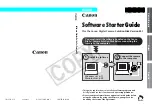
Appendix A: Glossary
A-5
Download.
The process of copying firmware or software from a computer to another computer
or other device on the network (such as a print server).
Driver.
Low-level software that interfaces a hardware device such as a printer to the computer's
operating system. The driver allows programs running on the computer to access the hardware
device in a relatively simple manner.
EBCDIC.
E
xtended
B
inary
C
oded
D
ecimal
I
nterchange
C
ode. EBCDIC is a character en-
coding set used by IBM mainframes and AS/400s. EBCDIC is an 8-bit extension of BCDIC
(Binary Coded Decimal Interchange Code), an earlier 6-bit character set used on early IBM main
frames. EBCDIC is IBM’s equivalent to ASCII.
IBM created 57 national EBCDIC character sets and an International Reference Version (IRV)
based on ISO 646 (and hence ASCII compatible). US EBCDIC uses more or less the same
characters as ASCII, but different code points. It has non-contiguous letter sequences, some
ASCII characters do not exist in EBCDIC (e.g. square brackets), and EBCDIC has some char-
acters (“cent” sign, “not” sign) not in ASCII. As a consequence, the translation between ASCII
and EBCDIC was never officially completely defined. Users defined one translation, which re-
sulted in a so-called de-facto EBCDIC containing all the characters of ASCII that all ASCII-
related programs use.
File Server.
A computer responsible for the central storage and management of data files so
that other computers on the same network can access the files.
Gateway.
A hardware or software set-up that translates between two dissimilar protocols, or
more commonly used to describe any mechanism for providing access to another system.
Escape Sequence.
A series of characters, usually starting with the ESCAPE character (ASCII
27), that is used to control a printer or print job. PCL commands use escape sequences.
Ethernet.
The most popular Local Area Network standard, which was developed originally by
Xerox, Intel, and Digital Equipment Corporation.
Ethernet II.
1. The second generation of Ethernet, which was developed before the IEEE
802.3 standard. 2. A frame that is compatible with the Ethernet II standard.
Ethernet_SNAP.
Ethernet
S
ub-
N
etwork
A
ccess
P
rotocol, an Ethernet frame type that is de-
rived from the 802.2 standard.
FTP.
File Transfer Protocol, a TCP/IP-related protocol for transferring files between devices on
a network.
File Server.
A device on a local area network that provides services to client computers on the
network, such as file sharing, print services, etc.
















































